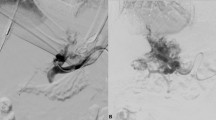Abstract
Purpose: To evaluate the efficacy and safety of using double-occlusion balloon catheters in preoperative portal vein embolization (PVE) to induce future remnant liver hypertrophy. Materials and Methods: PVE was achieved with gelatin sponges by using double-occlusion balloon catheter in seventeen patients with hepatobiliary malignant tumors. The ipsilateral approach was used in thirteen patients and the contralateral approach in four patients due to large size of tumor in the right hepatic lobe. Surgery was performed in 15 patients, 14–27 days (mean, 21.9 days) after PVE. Computed tomographic liver volumetric studies were performed before embolization and before surgery. The changes in aspartate aminotransferase (AST), alanine aminotransferase (ALT), prothrombin time (PT), and total bilirubin levels before and after the PVE were evaluated. Complications were evaluated after PVE. Results: PVE using double-occlusion balloon catheter was successful in all cases, irrespective of approach technique. The future remnant liver (FRL) volumes were 251–920 cm3 (mean, 437 cm3) before PVE and 281–1042 cm3 (mean, 555 cm3) after PVE. The mean increase in the volume of the FRL was 28.6%; this represented 37% of the preresection volume of the liver. Clinical and biologic tolerance of PVE was mandatory. There were no complications. Conclusions: PVE using the double-occlusion balloon catheter is safe and well-tolerated and can be performed technically with ease. This hypertrophy allows hepatectomy to be performed safely when the FRL volume is initially insufficient in patients with hepatobiliary tumors.




Similar content being viewed by others
References
M Makuuchi K Takayasu T Takuma et al. (1984) ArticleTitle[Preoperative transcatheter embolization of the portal venous branch for patients receiving extended lobectomy due to bile duct carcinoma]. Nihon Rinshogeka Gakkai Zasshi 45 1558–1564
M Makuuchi BL Thai K Takayasu T Takayama T Kosuge P Gunven S Yamazaki H Hasegawa H Ozaki (1991) ArticleTitlePreoperative portal embolization to increase safety of major hepatectomy for hilar bile duct carcinoma: A preliminary report. Surgery 107 521–527
H Kinoshita K Sakai K Hirohashi S Igawa O Yamasaki S Kubo (1986) ArticleTitlePreoperative portal vein embolization for hepatocellular carcinoma. World J Surg 10 803–808 Occurrence Handle1:STN:280:BiiD2cvjtVE%3D Occurrence Handle3022488
N Nakano K Miura H Takahashi et al. (1986) ArticleTitleHepatocellular carcinoma: Combined hepatic, arterial, and portal vein embolization. Radiology 161 303–307 Occurrence Handle3020611
T De Baere A Roche D Vavasseur E Therasse S Indushekar D Elias C Bognel (1993) ArticleTitlePortal vein embolization: Utility for inducing left hepatic lobe hypertrophy before surgery. Radiology 188 73–77 Occurrence Handle1:STN:280:ByyB1cfptVE%3D Occurrence Handle8511321
KC Lee H Kinoshita K Hirohashi S Kubo R Iwasa (1993) ArticleTitleExtension of surgical indications for hepatic carcinoma by portal vein embolization. World J Surg 17 109–115
M Nagino Y Nimura N Hayakawa (1993) ArticleTitlePercutaneous tranhepatic portal embolization using newly devised catheters: Preliminary report. World J Surg 17 520–524
M Nagino Y Nimura J Kamiya S Kondo K Vesaka Y Kin Y Kutsuna N Hayakawa H Yamamoto (1995) ArticleTitleRight and left trisegment portal embolization before hepatic trisegmentectomy for hilar bile duct carcinoma. Surgery 117 677–681 Occurrence Handle1:STN:280:ByqB1MnoslY%3D Occurrence Handle7778031
M Nagino Y Nimura J Kamiya S Kondo K Vesaka Y Kin N Hayakawa H Yamamoto (1995) ArticleTitleChanges in hepatic lobe volume in biliary tract cancer patients after right portal vein embolization. Hepatology 21 434–439 Occurrence Handle10.1016/0270-9139(95)90104-3 Occurrence Handle1:STN:280:ByqC2cngsVw%3D Occurrence Handle7843717
K Yamakado K Takeda Y Nishide J Jin K Matsumura A Nakatsuka T Hirano N Kato T Nakagawa (1995) ArticleTitlePortal vein embolization with steel coils and absolute ethanol: A comprehensive experimental study with canine liver. Hepatology 22 1812–1818 Occurrence Handle10.1016/0270-9139(95)90210-4 Occurrence Handle1:STN:280:BymD1cfosVU%3D Occurrence Handle7489993
T De Baere A Roche D Elias P Lasser C Largrange V Bousson (1996) ArticleTitlePreoperative portal vein embolization for extension of hepatectomy indications. Hepatology 24 1386–1391 Occurrence Handle10.1053/jhep.1996.v24.pm0008938166 Occurrence Handle1:STN:280:ByiD1M3nsVI%3D Occurrence Handle8938166
K Ogasawara J Urchino Y Une Y Fujioka (1996) ArticleTitleSelective portal vein embolization induces hepatic hypertropy and makes more extensive hepatectomy possible. Hepatology 23 338–345 Occurrence Handle10.1053/jhep.1996.v23.pm0008591861 Occurrence Handle1:CAS:528:DyaK28XhvVaqtrg%3D Occurrence Handle8591861
DA Turner A Doolas B Silver TAS. Matalon (1990) Role of cross-sectional imaging in hepatic resections. J Ferrucci DG Mathieu (Eds) Advances in hepatobiliary radiology Mosby-Year Book St. Louis, MO 209–227
RA Malt (1985) ArticleTitleSurgery for hepatic neoplasms. N Engl J Med 313 1591–1596 Occurrence Handle1:STN:280:BimD28rjsVU%3D Occurrence Handle2415822
H Bismuth D Houssin D Castaing (1982) ArticleTitleMajor and minor segmentectomies “reglees” in liver surgery. World J Surg 6 10–24 Occurrence Handle1:STN:280:Bi2B38rotVw%3D Occurrence Handle7090385
Isselbacher K, Braunwald E, Wilson J, Martin J, Fauci A (1994) Harrison’s principle of internal medicine, thirteenth ed, McGraw-Hill, New York, pp 1496
R Wright KG Albert S Karran GH. Millward-Sadler (1979) Liver and biliary disease Saunders Philadelphia
M Nagino Y Nimura J Kamiya S Kondo M Kanai (1996) ArticleTitleSelective percutaneous transhepatic embolization of the portal vein in preparation for extensive liver resection: The ipsilateral approach. Radiology 200 559–563 Occurrence Handle1:STN:280:BymB1MvlvF0%3D Occurrence Handle8685357
Author information
Authors and Affiliations
Corresponding author
Rights and permissions
About this article
Cite this article
Kim, M., Choo, S., Do, Y. et al. Use of Double-Occlusion Balloon Catheter: Preoperative Portal Vein Embolization for Induction of Future Remnant Liver Hypertrophy . CVIR 27, 16–20 (2004). https://doi.org/10.1007/s00270-003-0505-z
Published:
Issue Date:
DOI: https://doi.org/10.1007/s00270-003-0505-z




